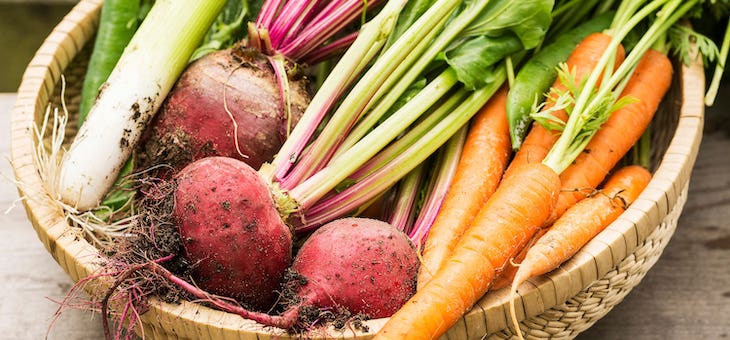Gardening has a reputation for being difficult and finicky. Of course, there’s plenty to think about and explore but the bottom line is that plants really want to grow given half the chance.
Drawing up a crop rotation system as part of your growing season’s planning is a tried-and-tested way of giving your crops a helping hand toward a rewarding harvest.
Now is a great time for beginner gardeners to get to grips with plant families and crop rotation, for the best chance of success with veg grown as annuals – the ones you will sow and harvest within one year.
There are four major groups of vegetables.
1. Brassicas: members of the cabbage family including cabbage, Brussels sprouts, broccoli, cauliflower, kale, kohlrabi, oriental greens, radish, swede and turnip.
2. Legumes: members of the pea family including peas, broad beans (although French and runner beans can be grown wherever convenient) and clover, which is used as green manure. Legumes can fix nitrogen from the air in root nodules and, if left to decompose in the soil, will be beneficial to later crops.
3. Potato family: potatoes and tomatoes (peppers and aubergines can be grown anywhere in the rotation).
4. Roots: beetroot, carrot, celery, celeriac, parsley, parsnip, Florence fennel and all other root crops except swedes and turnips.
How crop rotation works
Traditionally, you create four beds within your growing space, one for each of these groups of vegetables, and rotate the groups between beds each year, moving them in the same order and direction, so you avoid planting the same crop in the same place more than one year in four, to help prevent root diseases.
This also helps make the most of their soil requirements, as brassicas and roots benefit from the soil being given a top-dressing of lime, while potatoes and legumes prefer soil that has been manured. Alternate treatments help keep the soil balanced, while soil structure benefits from having a deep-rooted crop one year and a shallow-rooted one another.
The benefits of crop rotation
As already mentioned, grouping plants together by their nutritional needs is an effective way of keeping your soil fertile and healthy without resorting to chemical fertilisers. However, crop rotation offers other benefits, too.
- Crops in the same group tend to have similar sowing and harvesting times, making space management easier.
- Different crop groups have different depths of root systems. Rotation spreads the nutritional load over different layers of the soil from year to year, giving each one more time to recover.
- Similar crops will benefit from a common watering, mulching, and feeding regimen.
- Most plants can be afflicted by a disease of some type. Plants in the same group tend to be at risk from the same diseases, and it’s easier to protect them when they’re planted together. Added to that, any infected debris left behind after an outbreak is far less likely to pass the disease on to the next crop when a different group is rotated into that space.
- Rotating crops can also help prevent crop-specific pests from becoming established in your garden.
What about modern crops?
The old system doesn’t take into account modern crops such as sweetcorn and courgettes, but many people don’t want to devote a quarter of their plot to maincrop potatoes. If that’s the case, just divide the plot into three and grow courgettes with peas and beans.
Salads and other quick crops can be grown in the gaps between the rows of slower-growing, bigger crops. Onions, pumpkins, salad leaves and stem and fruiting vegetables can slot in where there is space, although onions are often grown with legumes.
Who should use crop rotation?
Crop rotation can benefit any grower, but it’s especially useful for those who want to follow a more natural cycle and minimise the use of chemicals and other intensive methods.
It’s also good for smaller scale gardeners who want to grow a wide variety of crops in a smaller space. Getting the most out of a small area relies on careful soil care, and crop rotation provides an excellent foundation.
Of course, crop rotation isn’t for everyone. It takes more planning and knowledge than dousing your soil with fertilisers and pesticides each year to try and maintain growing success. However, if you prefer to use sustainable and natural methods whenever possible, then crop rotation is an essential and effective technique to use.
And if you forget …
So, in all the excitement of your new vegies, you may forget what you grew on a piece of ground the previous year. Don’t worry, just remember these important points:
Don’t grow potatoes in the same spot two years running, because they are hungry feeders and will leave the soil depleted of nutrients.
Add lime to the soil in autumn after growing potatoes and grow peas or beans on that piece of ground. Peas and beans are great nitrogen-fixers, producing plenty of nutrients for any crop that follows them, including brassicas.
With root crops, don’t dig in manure before planting as they won’t like it. Instead, apply manure once you have harvested the root crops in autumn, so the soil will be replenished in anticipation of potato planting.
What about perennial veg?
Perennial veg, including rhubarb, artichokes and perpetual spinach, should go into separate beds where they can be left undisturbed. Asparagus needs its own bed and will take a couple of years before you can harvest it.
What are you growing this year? Do you have a crop rotation system in place?
– With PA
If you enjoy our content, don’t keep it to yourself. Share our free eNews with your friends and encourage them to sign up.
Related articles:
https://www.yourlifechoices.com.au/finance/news/make-your-garden-grow-money
https://www.yourlifechoices.com.au/lifestyle/leisure/creating-a-garden-when-space-is-limited
https://www.yourlifechoices.com.au/health/wellbeing/how-to-get-your-garden-thriving

